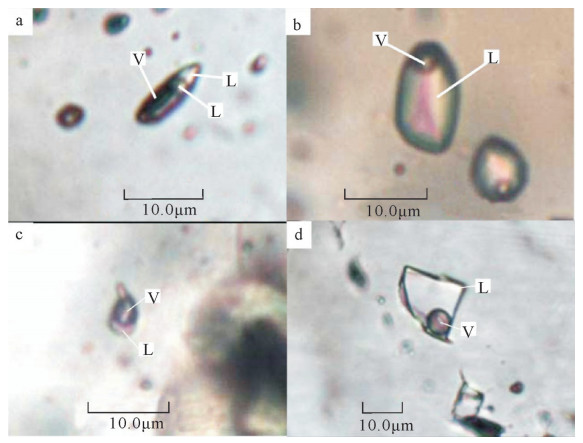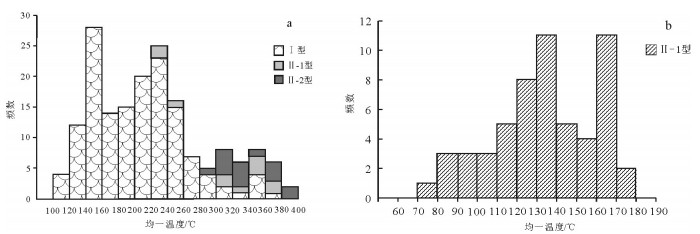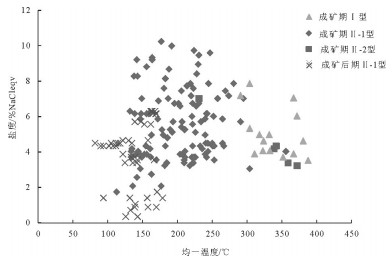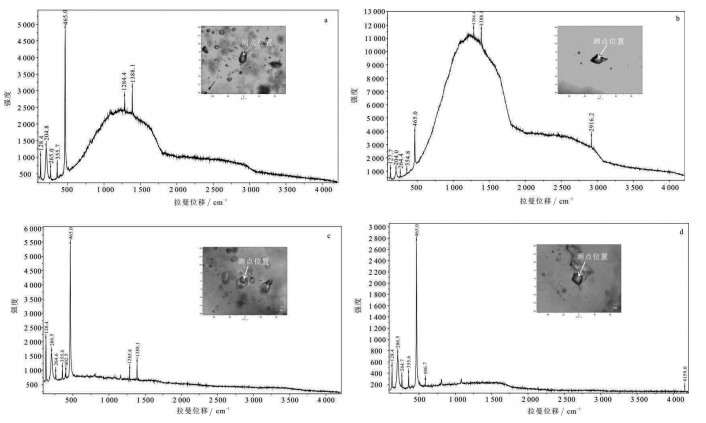Fluid inclusion studies of the Changpai area in Zhuguang Mountain, northern Guangdong Province
-
摘要:
长排矿区位于诸广山岩体南部,是近年来铀矿找矿重点突破的新成果。流体包裹体岩相学特征显示,该矿区成矿期主要发育2种类型包裹体:含CO2三相包裹体(Ⅰ型)和气液两相包裹体(Ⅱ型)。其中,Ⅱ型包裹体又可分为富液相包裹体(Ⅱ-1型)和富气相包裹体(Ⅱ-2型)。根据流体包裹体岩相学特征和显微测温结果,可将成矿期流体包裹体划分为2组:第1组均一温度主要集中在291~388℃之间,盐度范围为3.23%~7.87% NaCleqv,为Ⅰ型含CO2三相和Ⅱ-2型富气相包裹体;第2组均一温度范围主要集中于140~260℃之间,盐度为1.74%~10.24% NaCleqv,属Ⅱ-1型富液相包裹体,分别代表成矿期早阶段和晚阶段流体性质。晚阶段流体包裹体相对于早阶段具有较低的均一温度和较大的盐度变化范围,说明成矿期晚阶段很可能发生了不同来源流体的混合作用。激光拉曼分析显示,成矿期流体包裹体气相成分主要为CO2、CH4、H2等。硫同位素分析结果显示,成矿期黄铁矿δ34S值在-10.2‰~-3.2‰之间,与华南地区其他铀矿床成矿期硫化物的δ34S值相近。结合区域地质特征可知,长排矿区成矿物质主要来源于古老含铀地层部分熔融形成的富铀花岗岩;温度降低和流体混合作用可能是导致铀络合物水解沉淀的重要因素。
Abstract:The Changpai area, located within the southern part of the Zhuguang Mountain, is an important prospecting area in South China. In this paper, the authors present new fluid inclusion and stable isotopic data of the study area to discuss the nature of the oreforming fluids and uranium mineralization. Two types of fluid inclusions of the mineralization stage were recognized by petrographic observations:three-phase CO2-rich (type Ⅰ) and two-phase vapor-liquid (type Ⅱ) fluid inclusions. Type Ⅱ fluid inclusions include two sub-types, i.e. liquid-rich (type Ⅱ-1) and vapor-rich (type Ⅱ-2). Based on petrographic features and the results of microthermometry, the fluid inclusions from the mineralization stage can be classified into two suites:(1) type Ⅰ and Ⅱ-2 fluid inclusions with homogenization temperatures of 291~388℃ and salinities of 3.23%~7.87% NaCl equivalent; (2) type Ⅱ-1 fluid inclusions with homogenization temperatures of 140~260℃ and salinities of 1.74%~10.24% NaCl equivalent. The fluid inclusions of suite 1 and 2 represent the early and late sub-stages of fluids during the mineralization stage, respectively. Raman analyses of fluid inclusions show that the vapor ingredient of the ore-forming fluid inclusions contains CO 2, CH4 and H2. S isotopic compositions (δ34S=-10.2‰~-3.2‰) of the pyrites associated uranium mineralization are similar to those from other U deposits in South China. The fluid inclusions of suite 2 are characterized by wide range of salinities and have lower homogenization temperatures than those of suite 1, indicating that fluid mixing process took place. Combined with geological features, the authors hold that U was derived from the granite which was associated with partial melting of uranium-rich ancient crust, and that temperatures declining and fluid mixing played a key role in U precipitation.
-
Key words:
- fluid inclusion /
- Raman spectroscopy /
- S isotope /
- Changpai area /
- Zhuguang Mountain
-

-
图 1 长江铀矿田及长排矿区地质图(据参考文献[26]修改)
Figure 1.
表 1 长排矿区流体包裹体显微测温结果
Table 1. The temperature determination of fluid inclusions at Changpai
成矿期次 包裹体类型 测试
数目CO2包裹体 均一温度/℃ 冰点/℃ 盐度/%NaCleqv 初溶温度/℃ 笼形物消失温度/℃ 部分均一温度/℃ 范围 平均 范围 平均 成矿期 I 17 -61.9~-58.9 5.5~8.2 19.7~29.4 291~388 338 - 3.52~7.87 5.40 Ⅱ-1 149 - - - 113~356 199 -6.8~-1 1.74~10.24 5.52 Ⅱ-2 12 - - - 222~378 314 -4.4~-1.9 3.23~7.02 4.63 成矿后期 Ⅱ-1 56 - - - 80~179 134 -3.9~-0.2 0.35~6.3 3.8 表 2 长排矿区黄铁矿硫同位素组成
Table 2. S isotopic compositions of the pyrite from the Changpai area
序号 样号 矿物 δ34s/‰ 岩石名称 1 GZN201-3 黄铁矿 -9.1 产于灰色微晶石英脉屮 2 GZN201-1 黄铁矿 -3.2 产于灰色微晶石英脉屮 3 GZN201-11 黄铁矿 -9.7 产于猪肝色赤铁矿化蚀变花岗岩屮 4 ZK11-2-2 黄铁矿 -10.7 产于肉红色微晶硅质脉屮 -
[1] 毛景文, 谢桂青, 李晓峰, 等.华南地区中生代大规模成矿作用与岩石圈多阶段伸展[J].地学前缘, 2004, 11(1):45-55. doi: 10.3321/j.issn:1005-2321.2004.01.003
[2] 毛景文, 谢桂青, 郭春丽, 等.华南地区中生代主要金属矿床时空分布规律和成矿环境[J].高校地质学报, 2008, 14(4):510-526. doi: 10.3969/j.issn.1006-7493.2008.04.005
[3] Hu R Z, Bi X W, Zhou M F, et al. Uranium metallogenesis in South China and its relationship to crustal extension during the Cretaceous to Tertiary[J]. Economic Geology, 2008, 103:583-598. doi: 10.2113/gsecongeo.103.3.583
[4] 范洪海, 何德宝, 徐浩, 等.全国花岗岩型铀矿资源潜力评价[J].铀矿地质, 2012, 28(6):335-341. doi: 10.3969/j.issn.1000-0658.2012.06.004
[5] 陈振宇, 黄国龙, 朱捌, 等.南岭地区花岗岩型铀矿的特征及其成矿专属性[J].大地构造与成矿学, 2014, 38(2):264-275. http://d.old.wanfangdata.com.cn/Periodical/ddgzyckx201402006
[6] 蔡煜琦, 张金带, 李子颖, 等.中国铀矿资源特征及成矿规律概要[J].地质学报, 2015, 89(6):1051-1069. doi: 10.3969/j.issn.0001-5717.2015.06.005
[7] 胡瑞忠.花岗岩型铀矿床成因讨论——以华南为例[J].地球科学进展, 1994, 9(2):41-46. http://www.wanfangdata.com.cn/details/detail.do?_type=perio&id=QK199400049191
[8] 张国全, 胡瑞忠, 商朋强, 等.华南花岗岩型铀矿床成矿机理研究进展[J].矿物岩石地球化学通报, 2007, 26(4):399-404. doi: 10.3969/j.issn.1007-2802.2007.04.013
[9] Cuney M. The extreme diversity of uranium deposits[J]. Mineralium Deposita, 2009, 44(1):3-9. doi: 10.1007/s00126-008-0223-1
[10] 胡瑞忠, 李朝阳, 倪师军, 等.华南花岗岩型铀矿床成矿热液中ΣCO2来源研究[J].中国科学(B辑), 1993, 23(2):189-196. http://www.cnki.com.cn/Article/CJFD1993-JBXK199302011.htm
[11] 李子颖.华南热点铀成矿作用[J].铀矿地质, 2006, 22(2):65-69. doi: 10.3969/j.issn.1000-0658.2006.02.001
[12] 凌洪飞.论花岗岩型铀矿床热液来源——来自氧逸度条件的制约[J].地质论评, 2011, 57(2):193-206. http://www.wanfangdata.com.cn/details/detail.do?_type=perio&id=dzlp201102005
[13] 秦明宽, 何中波, 刘章月, 等.准噶尔盆地砂岩型铀矿成矿环境与找矿方研究[J].地质论评, 2017, 63(5):1255-1269. http://d.old.wanfangdata.com.cn/Periodical/kcdz201801013
[14] 张金带, 李友良, 简晓飞.我国铀资源勘查状况及发展前景[J].中国工程科学, 2008, 10(1):54-60. doi: 10.3969/j.issn.1009-1742.2008.01.009
[15] Zhao K D, Jiang S Y, Dong C Y, et al. Uranium-bearing and barren granites from the Taoshan Complex, Jiangxi Province, South China:Geochemical and petrogenetic discrimination and exploration significance[J]. Journal of Geochemical Exploration, 2011, 110:126-135. doi: 10.1016/j.gexplo.2011.04.006
[16] 徐浩, 崔焕敏, 蔡煜琦, 等.桃山-诸广岩体铀矿床地质-地球物理找矿模式探讨[J].东华理工大学学报(自然科学版), 2011, 34(4):315-322. doi: 10.3969/j.issn.1674-3504.2011.04.003
[17] 蔡煜琦, 徐浩, 郭庆银, 等.江西省桃山地区花岗岩型铀矿预测及找矿方向[J].吉林大学学报(地球科学版), 2013, 43(4):1283-1291. http://d.old.wanfangdata.com.cn/Periodical/cckjdxxb201304025
[18] 黄国龙, 曹豪杰, 凌洪飞, 等.粤北油洞岩体SHRIMP锆石U-Pb年龄、地球化学特征及其成因研究[J].地质学报, 2012, 86(4):577-586. doi: 10.3969/j.issn.0001-5717.2012.04.004
[19] 黄国龙, 刘鑫扬, 孙立强, 等.粤北长江岩体的锆石U-Pb定年、地球化学特征及其成因研究[J].地质学报, 2014, 88(5):836-849. http://d.old.wanfangdata.com.cn/Periodical/dizhixb201405003
[20] 叶永钦, 叶松鑫, 许幼, 等.粤北长江铀矿田长排地区花岗岩体地球化学特征及其意义[J].地球科学与环境学报, 2015, 37(6):101-110. doi: 10.3969/j.issn.1672-6561.2015.06.009
[21] 池国祥, 赖健清.流体包裹体在矿床研究中的作用[J].矿床地质, 2009, 28(6):850-855. doi: 10.3969/j.issn.0258-7106.2009.06.013
[22] 范洪海, 陈金勇, 顾大钊, 等.纳米比亚欢乐谷地区白岗岩型铀矿床流体包裹体特征及成矿作用[J].矿床地质, 2015, 34(1):189-199. http://d.old.wanfangdata.com.cn/Periodical/kcdz201501012
[23] 陈辉, 倪培, 陈仁义, 等.浙江建德铜矿流体包裹体研究[J].高校地质学报, 2016, 22(1):1-11. http://d.old.wanfangdata.com.cn/Periodical/gxdzxb201601001
[24] 姚磊, 吕志成, 陈辉, 等.再谈矿山深部及外围找矿新发现及意义[J].南京大学学报(自然科学), 2018, 54(2):296-307. http://d.old.wanfangdata.com.cn/Periodical/njdxxb201802006
[25] 邓平, 任纪舜, 凌洪飞, 等.诸广山南体印支期花岗岩的SHRIMP锆石U-Pb年龄及其构造意义[J].科学通报, 2012, 57(14):1231-1241. http://www.wanfangdata.com.cn/details/detail.do?_type=perio&id=kxtb201214007
[26] Zhang C, Cai Y Q, Xu H, et al. Mechanism of mineralization in the Changjiang uranium ore field, South China:Evidence from fluid inclusions, hydrothermal alteration, and H-O isotopes[J]. Ore Geology Reviews, 2017, 86:255-253. http://cn.bing.com/academic/profile?id=aed3f59be06b005fc3df8a3fd704a992&encoded=0&v=paper_preview&mkt=zh-cn
[27] Bodnar R J. Reviced equation and table for determining the freezing point depression of H2O-NaCl solutions[J]. Geochim Cosmochim Acta, 1993, 57:683-684. doi: 10.1016/0016-7037(93)90378-A
[28] Steele-MacInnis M, Lecumberri-Sanchez P and Bodnar R J. HOKIEFLINCS_H2O-NACL:A Microsoft Excel spreadsheet for interpreting microthermometric data from fluidinclusions based on the PVTX properties of H2O-NaCl[J]. Computers and Geosciences, 2012, 49:334-337. doi: 10.1016/j.cageo.2012.01.022
[29] Sergeyeva E I, Nikitin A A, Khodakovsky I L, et al. Experimental investingation of equilibria in the system UO3-CO2-H2O in 25℃-200℃ temperature interval[J]. Geochemistry International, 1972, 9:900-910.
[30] 赵斌, 王声远, 吴厚泽, 等.高温高压实验地球化学[M].北京:科学出版社, 1995:142-166.
[31] 张国全.华南热液铀矿床地球化学研究——以302铀矿床为例[D].中国科学院地球化学研究所博士学位论文, 2008.
[32] 张祖还, 章邦桐, 等.华南产铀花岗岩及有关铀矿床研究[M].北京:原子能出版社, 1991.
[33] 何德宝, 范洪海, 孟艳宁, 等.粤北下庄铀矿田不同类型矿床成矿流体对比研究[J].地质与勘探, 2015, 51(2):303-311. http://d.old.wanfangdata.com.cn/Periodical/dzykt201502011
[34] Rye R O, Ohmoto H. Sulfur and carbon isotopes and ore genesis:A review[J]. Economic Geology, 1974, 69:826-842. doi: 10.2113/gsecongeo.69.6.826
[35] 王联魁, 刘铁庚.华南花岗岩铀矿H、O、S、Pb同位素研究[J].地球化学, 1987, (1):67-78. doi: 10.3321/j.issn:0379-1726.1987.01.010
[36] 章邦桐, 张祖还, 凌洪飞, 等.华南东部铀成矿作用与陆壳演化的关系及其远景分析[J].核科学与工程, 1994, 14(2):157-164. http://www.cnki.com.cn/Article/CJFDTotal-HKXY402.009.htm
[37] 陈培荣.华南东部中生代岩浆作用的动力学背景及其与铀成矿关系[J].铀矿地质, 2004, 20(5):266-270. doi: 10.3969/j.issn.1000-0658.2004.05.003
[38] 凌洪飞, 沈渭洲, 邓平, 等.粤北帽峰花岗岩体地球化学特征及成因研究[J].岩石学报, 2005, 21(3):677-687. http://d.old.wanfangdata.com.cn/Periodical/ysxb98200503009
[39] 冯明月, 何德宝.富铀花岗岩源岩特征[J].世界核地质科学, 2012, 29(1):1-8. doi: 10.3969/j.issn.1672-0636.2012.01.001
[40] 刘继顺, 章邦桐.华南陆壳铀地球化学演化与成矿[J].华东地质学院学报, 1992, 15(2):130-135. http://www.cnki.com.cn/Article/CJFDTOTAL-HDDZ199202004.htm
[41] 孙涛, 周新民, 陈培荣, 等.南岭东段中生代强过铝花岗岩成因及大地构造意义[J].中国科学(D辑), 2003, 33(12):1209-1218. http://www.wanfangdata.com.cn/details/detail.do?_type=perio&id=zgkx-cd200312010
[42] Langmuir D. Uranium solution-mineral equilibria at low temperatures with applications to sedimentary ore deposits[J]. Geochim. Cosmochim. Acta, 1978, 42:547-569. doi: 10.1016/0016-7037(78)90001-7
[43] 邵飞, 许健俊, 毛玉峰, 等.华南铀成矿省花岗岩型铀矿矿质卸载机制研究[J].铀矿地质, 2013, 29(3):146-171. doi: 10.3969/j.issn.1000-0658.2013.03.004
-




 下载:
下载:



